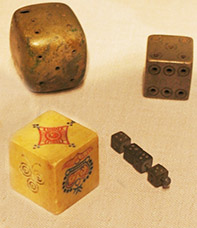Astragalomancy
Astragalomancy, derived from Greek terms astragalos (dice or knucklebone) and manteia (divination) involves the use of dice marked with letters and numerals.
Initially dice were fashioned out of knuckle bones or "astragals" of quadrupeds such as sheep and goats around the Mediterranean, particularly Athens.
The Greek practice of rolling dice was associated with the gods Hermes and Athena and was far more popular than visiting oracles. Divination with dice involved drawing a 12" circle on cloth and then dividing it into 12 equal portions, each numbered from 1 to 12. Dice would be rolled thrice and if one dice stayed put on top of the other it meant that the enquirer would be the recipient of something valuable.
European fortunetellers used an ancient method known as "The Part of Fortune" which included dice throws on a grid representing the planets. The result would be interpreted as the role of luck in a person's life.
In ancient occult practices, the days deemed most favourable to cast the dice were Mondays, Tuesdays, Wednesdays, Thursdays and Saturdays.
There is evidence that this method was also popular in Tibet. Tibetan Buddhist Llamas are known to engage in this practice to advise people on problems and their solutions.
Some African tribes use similar methods with marked marked bones or wooden dice.

